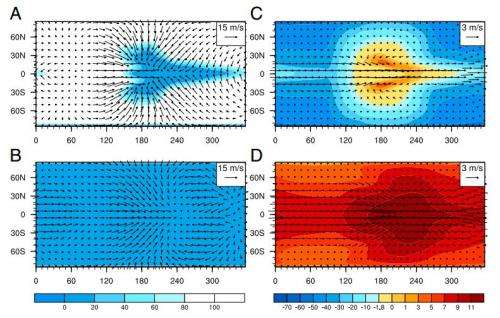Spatial distributions of sea-ice fraction and surface air temperature. (Left) Sea-ice fraction (unit, %); (Right) surface air temperature (unit, °C); (Upper) 355 ppmv CO2; and (Lower) 200,000 ppmv CO2. In A and B, arrows indicate wind velocity at the lowest level of the atmospheric model (990 hPa), with a length scale of 15 m s−1 . In C and D, arrows indicate ocean surface current velocity, with a length scale of 3 m s−1 . Note that the color scale for surface air temperature is not linear. The substellar point is at the equator and 180° in longtitude. Credit: PNAS, Yongyun Hu, doi: 10.1073/pnas.1315215111
(Phys.org) —A pair of researchers at Peking University in Beijing China, has extended the capabilities of an existing computer simulation that is used to study tidally locked exoplanets. In their paper published in Proceedings of the National Academy of Sciences, Yongyun Hu and Jun Yang describe the improvements they've made and also how those improvements give a new perspective on the range of possible tidally locked exoplanets that may be habitable.
Prior to this new effort, most computer models that sought to recreate the conditions that exist on exoplanets that are tidally locked (they don't spin, thus only one side ever faces their star) relied mostly on the impact of atmospheric conditions. The new enhancements include possible impacts of ocean currents.
The main goal of the upgraded model is, like many others, to allow for predicting the likelihood of life existing somewhere other than here on Earth. Tidally locked exoplanets present a challenging prospect—on one hand, the side that points towards the star is likely warm enough to support life—on the other, the cold side may be so cold that gases freeze and are lost to space preventing the evolution of an atmosphere.
To try to get a better handle on what may go on with such exoplanets, the researchers extracted parts of models that try to predict ocean behavior here on Earth. Those parts were then modified to more accurately reflect what has actually been observed, namely, smaller, colder and less feature rich worlds.
Tidally locked exoplanets generally exist close to a red dwarf star—they get locked because they move so close to their star. This means that the amount of heat hitting the star is much less, relatively speaking, than it would be for a planet that wasn't locked, because its star is colder. Space scientists tend to refer to such planets that might hold the potential for life as an "Eyeball Earth," because the dark side resembles a pupil.
The enhanced model, the team reports, allows for changing parameters (such as CO2 levels) and then for allowing many simulated years to pass to see what evolves as a result. Doing so, the team says, shows that given the right set of circumstances, heat from oceans can be transported around the globe allowing for a warmer planet than has been predicted before, though most outcomes suggest a narrower habitable zone.
The researchers note that much more work needs to be done on their model and others, noting that many are still too simplistic to render true approximations. One area of concern is that most models don't take into account land formations or uneven ocean bottoms, both of which can impact ocean currents and hence heat transfer.
More information: Role of ocean heat transport in climates of tidally locked exoplanets around M dwarf stars, PNAS, Yongyun Hu, DOI: 10.1073/pnas.1315215111
Abstract
The distinctive feature of tidally locked exoplanets is the very uneven heating by stellar radiation between the dayside and nightside. Previous work has focused on the role of atmospheric heat transport in preventing atmospheric collapse on the nightside for terrestrial exoplanets in the habitable zone around M dwarfs. In the present paper, we carry out simulations with a fully coupled atmosphere–ocean general circulation model to investigate the role of ocean heat transport in climate states of tidally locked habitable exoplanets around M dwarfs. Our simulation results demonstrate that ocean heat transport substantially extends the area of open water along the equator, showing a lobster-like spatial pattern of open water, instead of an "eyeball." For sufficiently high-level greenhouse gases or strong stellar radiation, ocean heat transport can even lead to complete deglaciation of the nightside. Our simulations also suggest that ocean heat transport likely narrows the width of M dwarfs' habitable zone. This study provides a demonstration of the importance of exooceanography in determining climate states and habitability of exoplanets.
Journal information: Proceedings of the National Academy of Sciences
© 2013 Phys.org
























